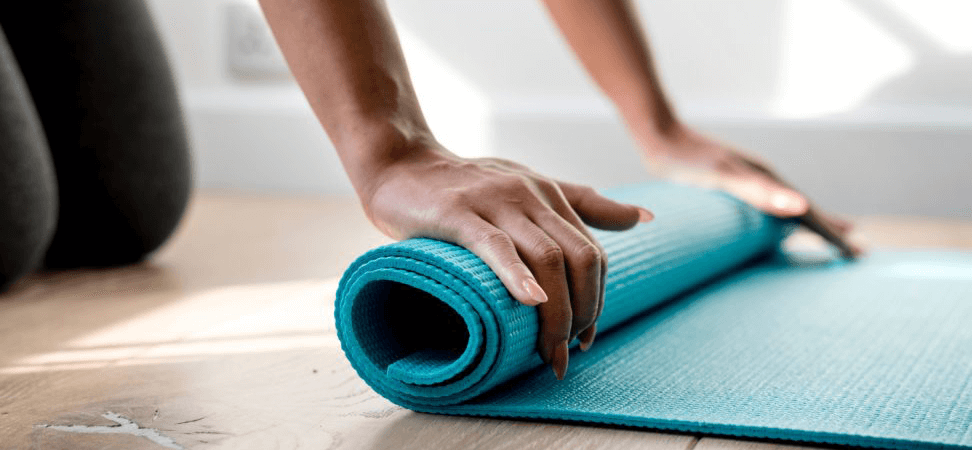With tax day falling in April, these 30 days seem like the right fit for Stress Awareness Month. I’ll admit that stress can still get the best of me. Throw in a childhood that introduced some unhealthy stress-management habits and, well, stress can really stress me out! Being more aware has helped. I’ve gotten better at recognizing building stress—and acting proactively.
Want to know one of the best stress-tackling tips?
Movement: A Reliable Method For Reducing Stress
 Exercise is one of the best things you can do for stress. I have been exercising with cardio and weights for some time now but had always read how much yoga impacted stress. So began to work with yoga a few days a week before bed. I’ve found that yoga is very doable. It’s easy to integrate into the day, and there are now many good online yoga programs that I (and you!) can do at home. I can destress with yoga at night or in the morning. Plus, there are the other physical benefits, like better balance and avoiding slips and falls and having stamina to get errands done.
Exercise is one of the best things you can do for stress. I have been exercising with cardio and weights for some time now but had always read how much yoga impacted stress. So began to work with yoga a few days a week before bed. I’ve found that yoga is very doable. It’s easy to integrate into the day, and there are now many good online yoga programs that I (and you!) can do at home. I can destress with yoga at night or in the morning. Plus, there are the other physical benefits, like better balance and avoiding slips and falls and having stamina to get errands done.
It’s so amazing the growing body of evidence that is confirming the benefits of yoga. The Mayo Clinic devotes a whole web page to the topic, stating that “Physical activity helps bump up the production of your brain’s feel-good neurotransmitters, called endorphins.” The Anxiety and Depression Association of America (ADAA) writes that “physical activity reduces stress” and that “scientists have found that regular participation in aerobic exercise has been shown to decrease overall levels of tension, elevate and stabilize mood, improve sleep, and improve self-esteem. Even five minutes of aerobic exercise can stimulate anti-anxiety effects.”
Penn State published a new study about the changes that mindfulness (being aware) combine with movement can bring to a person’s life. Quoting from a Forbes article on the study, “The team found that when participants were either moving or experiencing more mindfulness, they tended to feel better mentally. And when they were both moving and feeling mindful, their affect, or mood, and stress levels were even better. Not surprisingly, they were least happy when they were sitting.”
This study listed yoga as a good method for combining mindfulness and movement for stress reduction. Don’t think of yoga as fast or “sexy.” It is very doable for various bodies and abilities especially with modifications like chair yoga. You can find the right positions for you to improve your strength and flexibility. It’s about you! 
I also love how yoga can slow you down and reduce stress while still stimulating and strengthening muscles. For example, yoga can improve digestion by supporting the peristalsis action that moves food through our bodies. I’ve always struggled with digestion and I can tell my body is more “happy” when I keep up with my yoga. (Check out this short article for more on the connection between exercise and digestion.)
I could keep going with the number of benefits, but I’ll leave you with one more. Yoga improves our breathing, which has a cascade of good effects. Covering this topic, The American Lung Association shares how even gentle exercise is advantageous, writing …
Through gentle, breathing-based exercises, such as tai chi or yoga, you can improve your physical strength and keep your emotional energy in check. These practices not only improve lung health and capacity, but can also help one cope with the stress, anxiety and depression that unfortunately sometimes accompany a lung disease.”
I’ve seen so much evidence in my own life. Moving (and yoga, in particular) is so valuable for managing stress. In fact I loved it so much, I ended up getting a 200 hour certification in yoga so I can teach others this amazing stress relieving technique. I’m hoping this mixture of personal and professional insight will encourage you to de-stress and stay healthy.
Looking for more ideas for how to de-stress? Send me an email or give me a call!



![z31[1]](https://simplywholebydevi.com/wp-content/uploads/2018/06/z311-100x100.jpg)












